At 11am Wednesday, Hurricane Florence was located just over 500 miles southeast of Myrtle Beach, SC. It’s a massive storm that will have far-reaching impacts. Residents in the Carolinas should be wrapping up their preparations today.

Hurricane forecast winds currently extend out about 70 miles from the center, with tropical storm force winds extending out about 175 miles. Max sustained winds are at 130 mph. While conditions do favor some strengthening over the next 24 hours, eye wall replacement cycles will likely result in some intensity fluctuations. Overall, Florence is still expected to approach the coast as a major hurricane.


Track guidance is in very good agreement leading up to landfall over the next 48 hours, but as the storm slows, and perhaps stalls over the Carolinas, the forecast becomes incredibly tricky. In the last day or so, we’ve have seen a shift to a more southwesterly track as the storm moves inland – spreading the inland flooding threat southward, deeper into South Carolina. There will widespread 10-20″ totals by early next week, with possible isolated amounts of nearly double that. While coastal areas will deal with life-threatening storm surge and damaging winds, the inland freshwater flooding threat will be the most widely-felt impact of Hurricane Florence and should be taken very seriously. Reminder, this is just one model run of rainfall output. It’s important not to focus on individual numbers for a particular town, but rather the potential.

As noted above, storm surge flooding will be a major, life-threatening issue along the coast. As the storm slows down on it’s approach to the coast, a long period of strong onshore flow will result in a surge of 10-15’+ in the hardest hit areas east of the center of circulation. If you live near the coast and have been told to evacuate, please follow those orders. There is still time to leave through the day on Wednesday. Bottom line is, this is not a storm to mess with.


